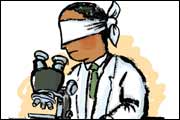Stem cell research offers hope
Politics is interfering with medical research that could bring hope to people with debilitating diseases.
Fred, a doctor, can no longer feed himself or brush his teeth because tremors from Parkinson’s disease have made it impossible. Even with adaptive equipment, he has to endure having others do these tasks for him.
Linda has end-stage multiple sclerosis: She is totally immobilized, communicating by blinking in response to yes or no questions, and is treated for depression when the silent tears run down her face.
Tom, Fred, and Linda are patients of mine at the VA hospital where I work as a geriatric and hospital dentist. Each is afflicted with a debilitating disease that may cause years more of suffering and disability. But now there is hope for curing these diseases through stem cell science—if religion-based political opposition can be overcome.
In 1998, Dr. James Thomson, a developmental biologist at the University of Wisconsin, removed cells from a donated embryo and grew the first line of human embryonic stem cells, a line that is still in existence today. Adult stem cells, which are isolated after birth, can be stimulated to become only a limited number of cell types. Embryonic stem cells are pluripotent, which means they have the potential to be stimulated into any tissue type. They also have the ability to replicate indefinitely in culture and to provide an unlimited supply of cells. In only eight short years, embryonic stem cells have been transformed into motor neurons, the type of nerve cell that could cure Lou Gehrig’s disease and spinal cord injuries. They have repaired severely damaged hearts in pigs and been transformed into retinal cells that someday may cure blindness. They have been grown into the inner ear hair cells that could cure many types of deafness, and transformed into islet cells that have stabilized diabetes in mice. Human trials of embryonic stem cell treatments are just beginning.
Embryonic stem cells are obtained from surplus embryos. These embryos are the byproducts of in vitro fertilization. They are the extra embryos that have been donated by couples who no longer need or plan to use them for further in vitro fertilization procedures.
The other branch of stem cell science is somatic cell nuclear transfer (SCNT), also referred to as therapeutic cloning. In SCNT, the nucleus is removed from an unfertilized human egg, allowing introduction of other genetic material that then produces a new line of cells. If the genetic material inserted is from someone with a genetically caused disease, a line of cells could be grown that would have the flaw that causes the disease. These cells could be used for faster, safer testing of medications and treatments to cure that disease. This technique may even allow generation of genetically matched replacement cells for disease sufferers, which would avoid the debilitating immune system inhibition now needed to permit organ and bone marrow transplants.
Opposition to SCNT comes from those who believe that stem cell research is the first step on “the slippery slope to human cloning” and from those who believe embryos are human beings with souls. But the goal of this process is to cure disease, not to clone humans. The eggs used for SCNT are eggs that did not become fertilized during in vitro fertilization or eggs specifically harvested from donors for the purpose of this research. SCNT does not generate embryos. Because SCNT and embryonic stem cell research are controversial, scientists have continued to look for a source of pluripotent stem cells that is not contentious. While other stem cell sources show promise, such as cells from amniotic fluid, it will be a long time until they are as available as embryonic stem cells. The delay in finding a source that is acceptable to all may well mean that cures come too late for many of those presently suffering from degenerative diseases.
In August 2001, George W. Bush announced that National Institute of Health (NIH) funding would be available only for the 78 stem cell lines that had already been generated. In actuality only 22 lines are in existence, available to researchers, and eligible for federal funding. These lines lack genetic diversity and were generated with early methods that produced poorer quality stem cell lines than are now available. They also include no disease specific lines, so scientists can’t use these stem cell lines to study diseases. The original lines were all isolated using a mouse-based media, and these lines would run the risk of introducing mouse viruses to humans, so they will not be usable to treat humans. In January 2007 legislation to allow NIH funding for all embryonic stem cell research passed the house by a very large margin, but still not enough to override the promised presidential veto.
Many of the brightest scientists of the upcoming generation have opted not to pursue stem cell science because the NIH prohibitions mean funding is so limited. Still, research and progress continue, both overseas and at home, but at a slower pace, funded by states, nonprofit foundations, and biotechnology firms. It is painful to wait for a cure but even more painful to realize that cures could be at hand were it not for political impediments.
My family joined millions of others who wait for a cure to debilitating diseases when my daughter’s pediatrician said to her, “Maggie, you have a disease called diabetes.” Our then twelve-year-old daughter had to learn to inject herself with insulin, something she needs to do four times a day. She tests her blood at least six times a day and calculates how many carbohydrates are in everything she eats. My daughter faces this challenge with grace and courage, but without a cure, she is likely to die 15 years earlier than her peers. She is also likely to endure amputations, blindness, early onset heart disease and renal failure before the end of her life. I hope stem cell research will lead to cures that spare other families such heartache.
Much of the stem cell debate has been framed in religious terms. Opponents of SCNT and embryonic stem cell research are vocal and influential. It is crucial that we as religious liberals raise our voices in support of stem cell science. We cannot allow other voices to claim the moral and ethical high ground unchallenged.
Last June the General Assembly passed an Action of Immediate Witness in support of stem cell science. There is much that we can do as individuals as well. For those whose legislators have voted against stem cell research in the past, write and tell them why you would like them to support it in the future. If your legislators have supported it, call, thank them, and encourage their continued support. The Juvenile Diabetes Research Foundation International has an excellent website with contact information for state and federal government representatives (JDRF.org). You can also support stem cell research by getting involved with patient advocacy groups supporting stem cell science, helping to sustain them with your time and financial contributions, and getting involved on a local level to advocate for state-based research funding. The Committee for the Advancement of Medical Research has a website that provides links to many advocacy groups (camradvocacy.org).
“I’ll give you hope, when hope is hard to find” is the refrain from “Come, Sing a Song With Me” in the Unitarian Universalist hymnal Singing the Living Tradition. Many diseases make hope hard to find. They can lead to deterioration and dependency, with little possibility of an altered course. Now, finally, stem cell science offers hope for cures to these afflictions.
See sidebar for links to related resources








